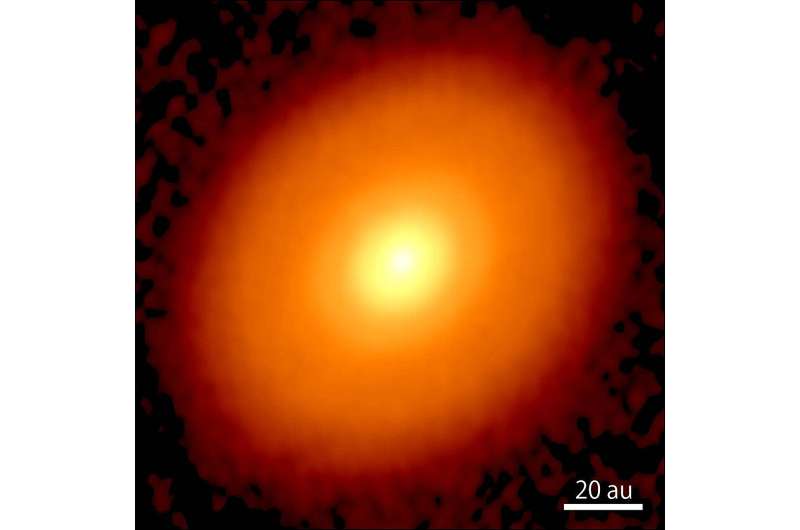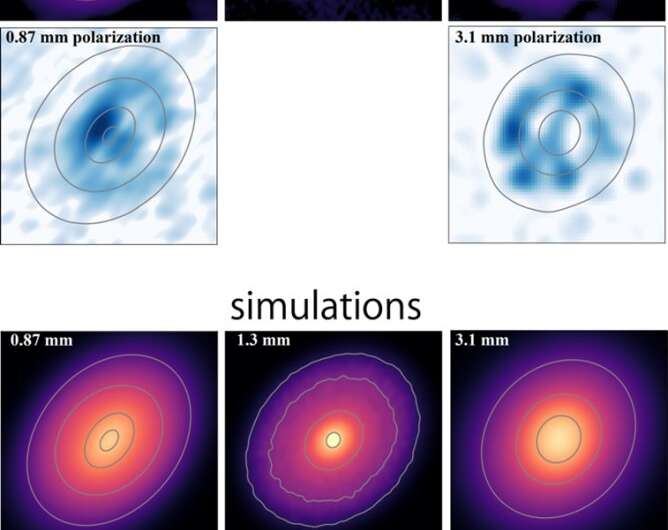This article has been reviewed according to Science X's editorial process and policies. Editors have highlighted the following attributes while ensuring the content's credibility:
fact-checked
peer-reviewed publication
proofread
Astronomers discover first step toward planet formation

Solving the mystery of how planets like Earth were formed is an important question for understanding the origin of life. Planets are thought to form when interstellar dust and gas collect in a protoplanetary disk surrounding a protostar, but it has been unclear where, when, or how planet formation begins.
On the other hand, it is known that when a planet is formed within a disk, its gravity creates a ring-like pattern on the disk. In fact, observations with ALMA have revealed such ring structures in many protoplanetary disks, suggesting the existence of planets.
In order to study the planet formation process, it is necessary to take a detailed look at disks where it is certain that no planets exist yet. However, due to the difficulties of finding such disks with no signature of planets and studying them in detail, we do not yet have a clear picture of how planet formation begins.
In the new study "Dust Enrichment and Grain Growth in a Smooth Disk around the DG Tau Protostar Revealed by ALMA Triple Bands Frequency Observations" published in The Astrophysical Journal, the international research group focused on a relatively young protostar, DG Taurus (DG Tau), and studied the disk surrounding the protostar in detail with ALMA.
They observed the distribution of radio emission intensity at a wavelength of 1.3 mm emitted by the dust in the disk with an extremely high spatial resolution of 0.04 arcsec, and clarified the detailed structure of the disk. The results show that the disk around DG Tau is smooth and lacks the ring-like patterns seen in the disks around older protostars. This indicates that there are no planets in the disk of DG Tau, and the image may have captured the eve of planet formation.

The researchers further observed the disk at different wavelengths (0.87 mm, 1.3 mm, and 3.1 mm) and investigated the radio wave and polarization intensities. Depending on the dust size and dust density, the ratio of radio wave intensities at different wavelengths and the polarization intensity of the radio waves scattered by the dust change. Therefore, the size and density distribution can be estimated by comparing the observation results with simulations with various patterns of dust size and density distribution.
This reveals the extent to which interstellar dust, the material from which planets are made, is growing. The best-fit simulations suggest that the dust is larger in the outer part of the disk (beyond about 40 astronomical units; a little farther than the distance between the sun and Neptune in the solar system) than in the inner part, indicating that the planet formation process is more advanced.
Theories of planet formation have suggested that planet formation begins in the inner part of the disk, but the results of this study contradict this expectation and indicate that planet formation may begin from the outer part of the disk. On the other hand, the dust to gas ratio was found to be about 10 times higher than in normal interstellar space in the inner region, although the dust size is smaller. Furthermore, these dust particles are well settled down onto the disk midplane, suggesting that the disk is in the process of accumulating material to form planets. It is possible that planet formation may be triggered by this dust accumulation in the future.
These observations were made possible by ALMA's extremely high spatial resolution of 0.04 arcseconds, as well as by the observation of radio waves emitted by the dust, including polarized light at three different wavelengths. This is the first time that the size and density of dust in a "smooth disk" with no signature of planets has been revealed. This has provided new information about planet formation sites that could not have been predicted by previous theoretical studies or observations of disks with signatures of planet formation.
Commenting on the significance of this research, Satoshi Ohashi says, "ALMA has so far succeeded in capturing a wide variety of disk structures and has revealed the existence of planets. On the other hand, however, to answer the question, 'How does planet formation begin?' it is important to observe a smooth disk with no signature of planet formation. We believe that this study is very important because it reveals the initial conditions for planet formation."
More information: Satoshi Ohashi et al, Dust Enrichment and Grain Growth in a Smooth Disk around the DG Tau Protostar Revealed by ALMA Triple Bands Frequency Observations, The Astrophysical Journal (2023). DOI: 10.3847/1538-4357/ace9b9
Journal information: Astrophysical Journal
Provided by ALMA





















